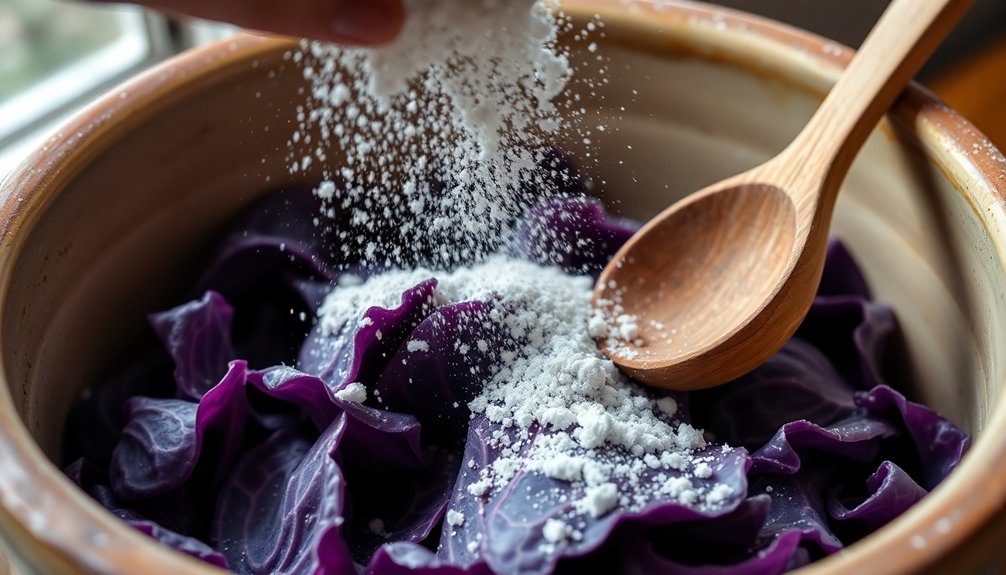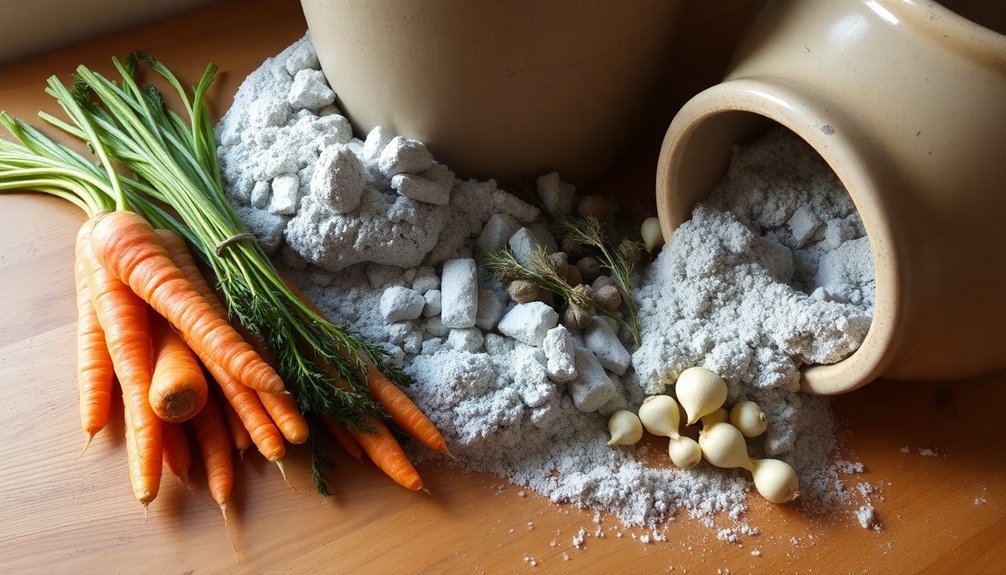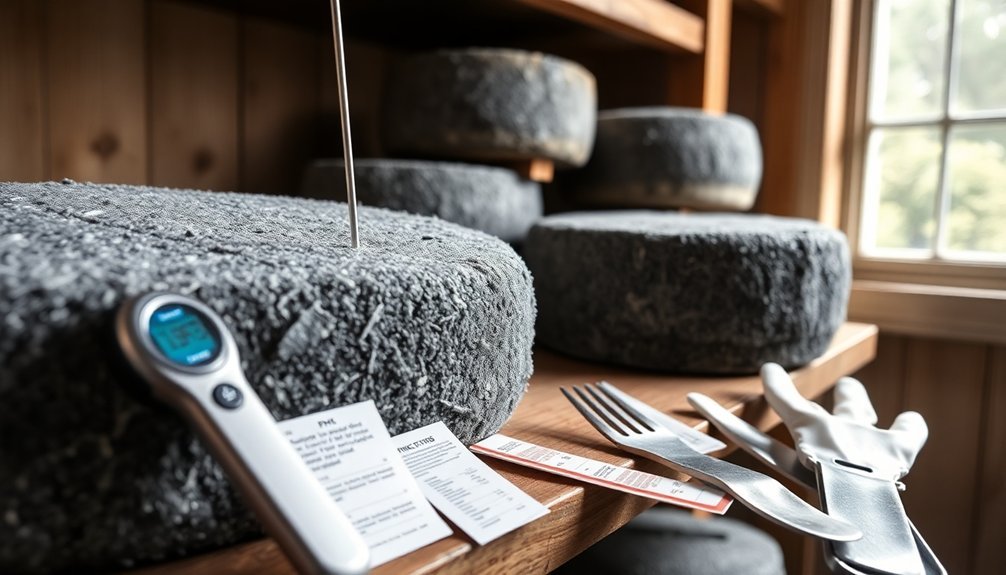You can preserve food using traditional wood ash techniques that have worked for generations. Start by collecting clean hardwood ash and sifting it thoroughly to remove debris. Layer your food items – like tomatoes, hard cheeses, eggs, or grains – in breathable containers like stoneware crocks or wooden boxes, ensuring each item is completely surrounded by ash. The ash's natural properties (calcium carbonate and potassium) help prevent spoilage while maintaining freshness. You'll need to store your containers in a cool, dark place around 50°F and check periodically for quality. These time-tested methods offer a chemical-free preservation approach that might surprise you with their effectiveness.
Understanding Wood Ash Properties

Wood ash is far more complex than just the remnants of burned timber. When you're considering using it for food preservation, you'll need to understand its rich chemical makeup. The ash contains 20-45% calcium, primarily as calcium carbonate or calcium oxide, along with up to 10% potassium and smaller amounts of magnesium and phosphorus.
You'll find that the ash's composition varies depending on several factors. The type of wood matters considerably – hardwoods yield more ash than softwoods, while bark and leaves produce higher quantities than inner wood. For optimal results, use ash only from natural wood sources, avoiding any treated or contaminated materials.
The temperature at which the wood burns also affects the final product's properties, particularly the formation of carbonates and oxides.
If you're planning to use wood ash, you should note its alkaline nature. It effectively raises soil pH, which translates to its preservative properties.
The ash contains an N-P-K ratio of roughly 0-1-3, but more importantly, it's rich in essential micronutrients like iron, aluminum, manganese, and zinc.
While it does contain trace amounts of heavy metals, research has confirmed that these levels are typically safe for agricultural and preservation purposes.
Essential Tools and Equipment
You'll need a variety of storage containers to effectively preserve food using wood ash methods, including stoneware crocks, mason jars, and airtight food storage boxes.
For sifting materials, you must have clean hardwood ashes that have been properly screened to remove any large particles or debris.
Your essential tools should also include muslin or tea towels for wrapping preserved items and glass containers for storing the sifted ash until you're ready to use it.
A cool cellar with temperatures around 50 degrees Fahrenheit is necessary for optimal preservation results.
Basic Storage Containers
When preserving food using traditional ash techniques, proper storage containers serve as the foundation for success. You'll need to choose between several traditional options, each offering unique benefits for different preservation needs. Wooden boxes and cardboard containers work well for storing tomatoes, while stoneware pots and earthenware crockery are ideal for preserving cheese and other items. The storage method works best when tomatoes are placed upside down in layers with ash.
Before using any container, you'll need to prepare it properly. Line wooden or cardboard boxes with paper to create a clean surface, and guarantee all containers remain dry. You'll want to cover your container with a secure lid, using a plate, stone, or brick to keep it in place.
| Container Type | Best Used For | Special Considerations |
|---|---|---|
| Wooden Boxes | Tomatoes | Requires paper lining |
| Woven Baskets | Tomatoes | Must be tightly woven |
| Stoneware Pots | Cheese | Needs proper sealing |
| Earthenware Crockery | Multiple foods | Maintains temperature well |
Remember to store your containers in a cool, dry place, preferably in a cellar or similar location with stable temperatures and minimal light exposure. This guarantees your preserved foods maintain their quality for the longest possible time.
Essential Sifting Materials
For successful ash preservation, gathering the right sifting materials stands as your first critical step.
You'll need several key tools to properly prepare your ash for food preservation. A fine mesh sifter or wire mesh strainer serves as your primary tool for removing unwanted particles and achieving the right texture. You'll also want to have a large spoon or trowel handy for moving and spreading the ash effectively.
Make certain you've got a proper sifting pan or tray that's dedicated to this process. A hand-held sieve provides extra precision when you're working with smaller batches of wood ash. As you sift, you'll need to pass the ash through your tools three to four times to guarantee thorough cleaning and uniform consistency.
Remember to use only cool ash from cooking fires or chimneys, and stick to hardwood ash when possible. Don't use ash from treated or painted wood, as it can contain harmful chemicals.
Keep your sifting materials clean and dry between uses, and store them separately from your regular kitchen tools to prevent cross-contamination.
Preparing Food for Ash Storage

Start your food preservation process by carefully inspecting each item for ripeness and blemishes, removing any damaged pieces that could spoil during storage.
You'll need to select an appropriate container, like a stoneware pot or wooden box, and prepare your ash through multiple siftings to achieve a fine, debris-free powder.
Once you've gathered your materials, layer the ash and food items methodically, starting with a thick base layer of ash and arranging your food items stem-side down before covering them completely.
Inspect and Clean Items
Proper inspection and cleaning of food items serve as the foundation for successful ash preservation. You'll need to carefully examine each item, selecting those that are freshly picked and ripe but still firm. Don't choose anything with bruises, blemishes, or signs of spoilage, as these imperfections can lead to rapid deterioration during storage.
When cleaning your items, use a gentle approach to avoid damaging them. You'll want to wash off any dirt or debris, but don't use harsh chemicals or soaps that could leave harmful residues. Make sure you're thoroughly drying each item, as excess moisture can compromise the preservation process.
For specific items like tomatoes and cheese, you'll need to pay special attention to their condition and size. If you're preparing eggs, remember to create a small hole at the peak if you plan to roast them in ash.
Handle everything with clean, sterile tools to prevent contamination, and work quickly to maintain freshness. You should check items one final time before storage, ensuring they're completely dry and free from any stems or leaves that could rot.
Keep your prepared items away from direct sunlight and heat until you're ready to store them in ash.
Select Container and Ash
Setting up your ash preservation system begins with choosing the right container and preparing suitable ash. You'll want to select either a wooden, cardboard, or woven basket, though earthenware crockery works well too. Make sure your container is clean, dry, and can be properly sealed to maintain preservation conditions.
For the ash itself, collect cool ash from your cooking fire or wood stove, focusing on the pure white ash from the top of the pile. You'll need to sift it multiple times to remove any debris or sharp particles, ensuring it's completely dry and clean.
| Container Type | Benefits | Considerations |
|---|---|---|
| Wooden Basket | Natural material | Must be fully dried |
| Cardboard Box | Easy to source | Single-use only |
| Woven Basket | Good ventilation | Check for gaps |
| Earthenware | Durable | Can be heavy |
| Storage Chest | Multi-purpose | Size limitations |
When you're ready to use your container, start by adding 1.5 inches of tamped-down ash at the bottom. You'll continue adding ash in layers as you place your food items, ensuring complete coverage to prevent air exposure. Store your sealed container in a cool, dark, dry place, away from direct sunlight and moisture.
Layer Food With Care
Four essential principles guide the layering of food in ash storage: careful food selection, proper preparation, precise placement, and complete coverage.
For tomatoes, you'll want to choose ripe but firm fruits without blemishes. Place them stem-side down in single layers, adding ash between each layer until your container's full. This prevents moisture buildup and guarantees even preservation.
When preserving cheese, you'll need pieces about 4" square and 1 1/2" thick. Make certain your cheese has completed its aging process before placing it in a stoneware pot with 1 to 1 1/2 inches of sifted wood ash surrounding it completely.
For eggs, you'll need to create a small hole at the peak of each intact egg. Position them upright in the ash bed with holes facing up, then carefully mound ash around them to three-fourths height, keeping the holes clear.
When preserving meat, you must first dry it thoroughly. Hang it using a stick to allow proper drainage, then place it in your container. Cover it completely with ash, preferably from legumes for better preservation.
Always store your ash-preserved foods in a cool, dry place.
Step by Step Preservation Process
The time-tested ash preservation method requires careful attention to detail and specific steps to guarantee ideal food storage.
You'll need to start by selecting the right container – opt for a wooden box, woven basket, or stoneware pot, and line it with paper to prevent direct food contact with ash.
Sift your wood ash thoroughly to remove any sharp particles, then create a base layer approximately 1.5 to 2 inches thick.
When storing your food items, position them strategically:
- Place tomatoes stem-side down in a single layer, ensuring they don't touch each other
- Arrange cheese in the center of your container, completely surrounded by ash
- Layer meats and produce separately, maintaining space between items
Cover each layer with a thin coating of ash and continue this pattern until you've filled the container.
Seal everything with a final ash layer and secure with a lid or plate – you can add a brick on top for extra stability.
Store your container in a cool, dark place like a cellar, and check periodically for any signs of spoilage.
While tomatoes can last up to six months, other foods may have different storage durations.
Best Foods for Ash Preservation

Success in ash preservation largely depends on selecting the right foods for storage. You'll find tomatoes are particularly well-suited for this method, staying juicy and wrinkle-free for up to six months when properly preserved in wood ash.
Hard cheeses and eggs are also excellent candidates, with eggs maintaining their quality for nearly a year when completely surrounded by ash.
When preserving meat, you'll want to use hickory ash specifically, as it not only preserves but also enhances the flavor, following traditional Cherokee practices.
For fruits and vegetables, select only ripe but firm specimens without any blemishes or bruises. You'll need to ascertain they're completely dry before preservation, as excess moisture can lead to spoilage.
Grains store exceptionally well in ash, which keeps them dry and protected from pests. While you can preserve various vegetables using this method, it's most effective with produce that has relatively low moisture content.
Remember that soft cheeses aren't suitable for ash preservation – stick to hard varieties. For all foods you're preserving, you'll need to sift the ash first to remove debris and ascertain even coverage.
Cultural Heritage of Ash Methods
Understanding the foods best suited for ash preservation leads us naturally to the rich cultural legacy behind these time-tested methods. When you explore the heritage of ash preservation, you'll find it deeply woven into the fabric of societies worldwide, passed down through generations as both practical knowledge and cultural wisdom.
The spiritual and social significance of ashes extends far beyond their practical use, representing renewal and transformation across many cultures. You'll discover this reflected in traditional practices like:
- Mesoamerican nixtamalization, where volcanic ash transforms corn into more nutritious forms
- Portuguese culinary traditions that incorporate ash preservation as part of their gastronomic identity
- Cherokee practices of using hickory ash for both preserving and flavoring meat
These methods aren't just about food storage – they're living connections to ancestral knowledge.
In Morocco, you'll find ash being used in traditional Tanjia preparation, while African farmers continue to preserve tomatoes using wood ash techniques that have sustained communities for generations.
This cultural diversity in ash preservation methods shows how different societies have adapted the technique to their specific needs and resources, creating unique solutions that reflect their environmental and cultural contexts.
Safety Measures and Precautions

Safe ash preservation requires following three essential principles: proper material selection, careful storage conditions, and rigorous handling practices. When you're working with wood ash, you'll need to prioritize both your safety and the food's integrity.
| Safety Area | Do's | Don'ts |
|---|---|---|
| Container Choice | Use breathable stoneware | Avoid plastic or glass |
| Storage Environment | Keep cool and dark | Don't expose to moisture |
| Wood Ash Selection | Choose clean hardwood ash | Never use contaminated ash |
| Handling Methods | Wear protective gear | Don't skip safety measures |
You'll need to protect yourself by wearing gloves and a mask when handling ash, as it can contain harmful substances. Store your preservation containers in a cool, dark place that's separate from living areas, and always use containers made from stoneware or earthenware to guarantee proper breathability.
Monitor your stored food regularly for signs of spoilage, and don't hesitate to discard anything suspicious. Before consuming fermented foods preserved in ash, you must boil them first to eliminate potential toxins. Remember to follow local health guidelines and keep your storage area clean and pest-free to maintain food safety.
Modern Applications of Ash Preservation
The ancient practice of ash preservation has found renewed relevance in today's sustainable food movement. You'll find modern homesteaders and food preservation enthusiasts combining traditional ash methods with contemporary techniques to maximize food longevity.
By integrating wood ash preservation with refrigeration or vacuum sealing, you're able to create more effective storage solutions for your food items.
You can apply this versatile preservation technique to various foods in your kitchen:
- Store hard cheeses like Gruyere in sifted wood ash within stoneware crocks, extending shelf life up to three months
- Preserve tomatoes and other produce using a layer of clean ash in earthenware containers
- Keep grains and dried meats protected from moisture and pests in ash-lined storage vessels
Today's application of ash preservation doesn't just stop at food storage.
Frequently Asked Questions
Can Wood Ash Preservation Affect the Taste of Preserved Foods?
Yes, you'll find that wood ash preservation can enhance your food's flavor. It'll make your cheese taste like aged parmesan, add unique flavors to meat, and the type of wood used affects the final taste.
How Do You Know When Ash-Preserved Food Has Gone Bad?
You'll know your ash-preserved food has spoiled if you spot mold, unusual colors, sliminess, or detect foul odors. Watch for bulging containers, gas formation, or any surface that's cracked or leaking.
Is It Safe to Preserve Different Foods Together in Ash?
You shouldn't preserve different foods together in ash. It can lead to cross-contamination and compromise preservation effectiveness. Keep each food type separate in different containers or layers to maintain safety and quality.
What Types of Wood Should Never Be Used for Food Preservation?
You should never use toxic woods like yew or rosewood, pressure-treated lumber, chemically treated woods, or open-grained woods like oak. These can release harmful substances or harbor bacteria in food preservation.
Can Ash-Preserved Foods Be Used in Cooking Without Additional Preparation?
You'll need to prepare most ash-preserved foods before cooking. While hard cheeses can be used directly, meats require rehydration, and produce needs washing. Don't forget to remove excess ash to avoid overpowering flavors.
In Summary
You've explored an ancient preservation method that's still relevant today. While modern refrigeration has largely replaced ash preservation, you can still use these techniques for unique flavors and sustainable food storage. Whether you're preserving eggs, root vegetables, or meats, remember to follow proper safety protocols and enjoy connecting with traditional food preservation methods that have sustained communities for generations.





Leave a Reply